Jürgen Krahl and Axel Munack
Federal Research Center
Müfit Bahadir
Technical Univ.
Leon Schumacher and Nancy Elser
University of Missouri
Copyright 1996 Society of Automotive Engineers, Inc.
International Fall Fuels and Lubricant Meeting. San Antonio, TX. SAE Paper No. 962096
Topics in Alternative Fuels and Their Emissions
Acrobat file (25.4Mb):
http://bengal.missouri.edu/~pavt0689/Review_Utilization_of_Rapeseed_Oil.pdf
1. Introduction
2. Engine Testing Procedures
3. Environmental Effects of the Main Exhaust Gas Components
3.1 Gaseous Regulated Components HC, CO, and NOx
3.2 Aromatic Compounds PAH and Diesel Soot
3.3 Environmentally Relevant Effects of Aldehydes and Ketones
4. Comparison of Emissions from Rapeseed Oil, RME and Diesel Fuels
4.1 Gaseous Regulated Exhaust Gas Components, Particulate Matter and Soot Number
4.1.1 Comparative Measurements of DF and Rapeseed Oil
4.1.2 Comparative Measurements of DF and RME
4.2 Non-Regulated Exhaust Gas Components PAH, Aldehydes and Aromatic Compounds
4.2.1 Comparative Measurements of PAH in DF and Rapeseed Oil
4.2.2 Comparative Measurement of PAH with DF and RME
4.2.3 Comparative Measurements of Aldehydes with DF and Rapeseed Oil
4.2.4 Comparative Measurements of Aldehydes with DF and RME
4.2.5 Comparative Measurements of Aromatic Compounds
4.3 Summary of the Known Test Results
5. Effects of Rapeseed Oil and RME
5.1 Gaseous Regulated Components
5.2 PAH, Particulate Matter and Soot
5.3 Aldehydes
5.4 Aromatic Compounds
5.5 Conclusion
Summary
References
1. Introduction
The use of rapeseed oil fuels in diesel engines has been intensively investigated since the beginning of the on-going energy crisis. In the beginning, the emphasis was placed on the technical possibilities associated with the use of rapeseed oil as a fuel. However, research has shown that pure rapeseed oil can only be used in specially designed engines, Research that followed indicated that rapeseed oil methyl ester (RME) was a suitable replacement for petroleum diesel fuel (DF) (Vellguth, [1]) After this discovery, research has focused on the engine exhaust emissions that result when fueling with both unmodified rapeseed oil and RME.
Initially, research concentrated on the federally regulated hydrocarbons (HC), carbon monoxide (CO) and nitrogen oxides (NOx) exhaust gas emissions (Vellguth, [2]). These components, and occasionally particulate matter (PM), have been investigated in a large number of studies and reports involving engine exhaust emissions testing. In addition, a series of current publications compare the environmentally important but non-regulated polycyclic aromatic hydrocarbons (PAH), aldehydes, ketones and in some cases, the aromatic compounds. According to the United States Clean Air Act (Gorse et al, [3]), butadiene, benzene, formaldehyde, acetaldehyde and polycyclic organic material are the principal toxic airborne exhaust gas components found in engine exhaust gas emissions. Butadiene, however, has not been reported when examining the exhaust gases of engines fueled with rapeseed oil and RME. Likewise, the influence of rapeseed oil fuels on the formation of photochemical smog, whose main component is ozone, is unknown. The undisputed advantages of rapeseed oil fuels, however, lie in their sulfur free emissions and the reduced atmospheric CO2 emissions.
An estimation of the environmental effects caused by emissions from engines fueled with rapeseed oil and rapeseed oil methyl ester fuels can be made by a relative comparison with DF. An evaluation of the potential health effects, as presented recently for gasoline and diesel-powered engines in an environmental assessment of the "Sachverständigenrates für Umweltfragen" [4]1 (German Authority Council for Environmental Issues), must be replicated for RME and rapeseed oil fuels.
The goal of this review is to summarize the published emissions measurements from different authors, to compare these results and, where possible, identify trends that may exist. In order to classify and evaluate the conclusions, it is necessary to begin with a description of the experimental conditions applied, or in other words, the engine testing procedures (section 2). The current state of knowledge concerning the environmental effects of the components of exhaust gas are discussed, in order to assess the environmental relevance of the test results. Section 4 contains a summary of the measured values, that are discussed under conclusions in section 5 regarding their environmental importance, whereby also some standing problems, whose research needs exist, are examined.
2. Engine Testing Procedures
The engine test procedures must be selected carefully. Engines emit harmful substances depending upon load and engine speed. A comparative evaluation of the engine exhaust emissions is only possible when specific engine testing procedures are employed. For automobiles, test cycles that contain city and highway portions should be used. The test cycles that are used most frequently include the American Federal Test Procedure (FTP), which simulates typical city and highway usage in Los Angeles (Code of Federal Regulations) and the European ECE-15-Test (ECE = European Commission for Europe). The ECE test procedure now includes a section that measures emissions at higher speeds to adjust to the traffic conditions that exist in Europe and is denoted MVEG-A-Test (Motor Vehicles Emissions Group).
The results of exhaust gas emissions from these test procedures are not directly comparable, as the driving cycles load the engines differently. For this reason, the limiting values of legally regulated emissions are always based upon the test applied (Schaefer, [5]). Table 1 provides a comparison of the results of the FTP-75 and the ECE-15 tests. A vehicle was fueled with rapeseed oil and diesel fuel and in each case was subjected to both driving cycles. The emission values of the rapeseed oil combustion are based on the respective value of DF (100%) (Menrad et al., [6]). The significant differences of the single values emphasize the influence of the engine test procedure on the results. For this reason it is necessary to indicate the test cycle used when specifying the emissions results and their comparison with limiting values.
Table 1: Exhaust gas emission (%) of a vehicle fueled with rapeseed oil compared to the emissions of a vehicle fueled with diesel fuel, using the FTP-75 and ECE-15 tests
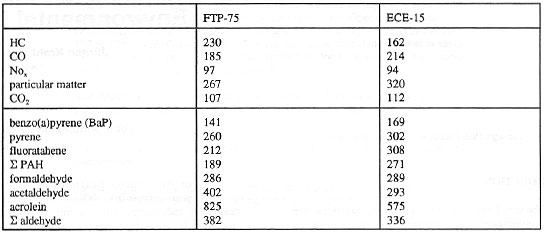
Worldwide many different test procedures are likewise available for trucks. In the EU (EU = European Union), truck emissions are analyzed using the 13 point steady-state test cycle ECE R49. This test describes the engine load with city use and takes into consideration the European driving style and construction of the vehicles (Fraenkle and Stein, [7]). Diagram 1 illustrates the selected operating points used during the engine emissions test procedure and the weighting factors for each part of the test. The idle point, which is weighted 8-1/3 % each time, is repeated three times during the test procedure.

Diagram 1: The load points of 13-, 8- and 5-mode tests.
Truck and car test cycles are not suitable to judge the engine exhaust from agricultural tractors. The simulated city and highway tests are not appropriate for agricultural vehicles, because the engines are loaded differently. The steady-state 5-mode test developed by Vellguth [2] has been adjusted for emissions testing of agricultural engines. This emissions test procedure is based on research conducted by Welschof [8], whereby 5 modes accurately predict the typical exhaust emissions profile of agricultural vehicles.
The US EPA has already adopted the International Standards Organization (ISO) 8-mode test to certify agricultural engines. This test is based on the 13-mode test. As is evident in diagram 1, only two engine speeds in addition to idling are considered. The first goal of this work is to test if the cycle recommended in the ISO plan 8178-Cl can be relied upon not only for certification but also to estimate the exhaust emissions actually produced by agricultural use.
In conclusion, in view of the comparability of the emissions values determined among the various test procedures, a direct comparison of the absolute values is not admissible. For this reason, the following results will be represented based on the engine test procedure used.
3. Environmental Effects of the Main Exhaust Gas Components
The effects of components of exhaust gas have been a subject of research for some time. Here the expected effects will be presented only in shortened form. Specialized information can be obtained from the extensive literature covering the subject. Information can be found in the studies of the "Länderausschuss für Immissionsschutz" (Studies of the German States for Emissions Protection) [9]), Lenz et al., [10] and Krahl et al., [11], and "Sachverständigenrat für Umweltfragen" (German Authority Council for Environmental Issues) [4].
3.1 Gaseous Regulated Components HC, CO, and NOx
The hydrocarbon emissions produced by motor traffic are either toxicologically of little relevance (alkanes, alkenes, as well as methane, ethane, or ethene) or can be carcinogenic (benzene, polycyclic aromatic hydrocarbons). The latter are handled separately in the following sections. Some hydrocarbons are also of importance in atmospheric chemistry (see section 3.3).
The carbon monoxide emissions arising from engine combustion, aside from suffocation in closed rooms or garages, are insignificant in light of the other environmental problems caused by motor traffic (Henschler, [12]).
Oxides of nitrogen contribute to the formation of acid rain. When combined with volatile hydrocarbons or aldehydes in the presence of sunlight, the concentration of ozone at low altitudes increases (see section 3.3). NO exhaust emissions are at a low enough concentration that they are not perceived as a health risk. In contrast, NO2 is a lung irritant that attacks the membranes of human lung alveoli, even in small doses (Henschler, [12]).
3.2 Aromatic Compounds PAH and Diesel Soot
Benzene, toluene, xylene and ethyl benzene are the main aromatic compounds that have been investigated in connection with engines fueled with rapeseed oil fuels. In accordance with the US Clean Air Act, benzene is an especially environmentally relevant and toxic airborne component (see section 1). In Germany, benzene is identified as a carcinogenic hazardous material (Gefahrstoffverordnung, Gruppe II) and as an unequivocal carcinogenic material (MAK III A1). The alkyl aromatic compounds are considerably less environmentally relevant with regard to their direct effect on humans.
In addition to the biological effect of aromatic compounds, the indirect influence of these compounds on tropospheric ozone formation must be taken into account when discussing engine exhaust emissions (see section 3.3). In this light, the importance of benzene and its alkyl derivatives is reversed, as the ozone formation potential of 1 g benzene is approximately 25 times less than that of 1 g 1,3,5-trimethyl benzene (Carter, [13]). At this time, however, there is little data evaluating the role of aromatic compounds produced by diesel exhaust emissions on ozone formation at low altitudes.
Polycyclic aromatic hydrocarbons (PAH) have become a known hazard for humans and the environment that must be taken seriously because of its carcinogenic and mutagenic properties. The individual PAH compounds have, dependent upon structure, varying tumor-inducing effects. Whereas benzo(e)pyrene has been shown to be non-carcinogenic, its structural isomer benzo(a)pyrene belongs to one of the most cancer-inducing substances in animal experiments (Huber et al., [14]). Different combinations of PAH can work synergistically or antagonistically, so it is impossible to predict the carcinogenic potential of a mixture of PAH according to the known effects of the single components (Heinrich, [15]: Kaschani and Brauns, [16]). When discussing PAH, one must also consider that the PAH itself is not the ultimate carcinogen, but rather a reactive metabolite, the PAH-diol-epoxide, possesses the tumor-inducing potential (Grover, [17]).
Even more complex is the association between the induction of lung tumors and diesel engine emissions (DEE). Not only the PAH compounds adsorbed to soot particles have a strong cancer-inducing potential, but the assumption can be made that the PAH-free soot also induces carcinomas. Experiments with rats have shown that soot which is virtually free of adsorbed organic compounds can induce lung cancer just as the actual diesel particles do. It is probable that soot, in connection with the deposited substances, is responsible for the formation of tumors (Heinrich, [15]; Pott, [18]; Boeckh, [19]). Independent of the question, whether the PAH, the pure carbon fraction or their added effect is the main inducer of lung cancer, the fact remains that DEE, because of its potential health hazard, was classified in 1987 as a human carcinogen (MAK III A2, maximum work area concentration) by the "Senatskommission der Deutschen Forschungsgemeinschaft" (Senate Commission of the German Research Community) when investigating health hazardous materials (MAK-Kommission) (Henschler, [20]).
3.3 Environmentally Relevant Effects of Aldehydes and Ketones
Aldehydes and ketones are compounds with a pungent, membrane-irritating smell. The most well-known example of this ciass of compounds is formaldehyde, whose detrimental effect on human health is well documented. Acrolein, a characteristic exhaust gas component of engines fueled by RME (Wurst et al., [21]), is considered a potential carcinogen (Office of Health, [22]). These effects, however, are not alone decisive for the environmental relevance of the carbonyl compounds emitted by engines, which have only a short half-life in the atmosphere (Lofti et al., [23]). More importantly, in the presence of NO2, aldehydes and ketones promote the formation of photo oxidants in air, the so-called "photochemical smog," which contains up to 90% ozone (Moussiopoulos et al., [24]; Wagner, [25]).
A large number of other mechanisms exist (Sattler and Jaeschke [26]), that are not reported in this paper. Most of the other hydrocarbon compounds found in exhaust gas also contribute to ozone formation in the atmosphere through complex chain reactions when sufficient NO2 is present (Moussiopolus et al., [24]). It has been estimated, that motor vehicle traffic in West Germany is responsible for nearly 30% of anthropogenic emission of volatile hydrocarbons (Reichow, (27]).
The automobile industry has shown more interest for ozone reduction than for either CO2 reduction or for energy savings (Krumm et al., [28]). To reduce the ozone burden, new limiting values for carbon dioxide emissions have been issued by the California Air Resources Board (CARB). No longer is the sum of all hydrocarbons totaled, but rather only the methane-free portion (Hockel et al., [29]), as methane contributes only slightly to ozone formation (Schaefer, [5]). The remaining hydrocarbons, along with a few other compounds in exhaust gas (such as carbonyl compounds, alcohols and ether), are designated NMOG (non-methane organic gases) and are regulated after 1994 for all automobiles from each manufacturer (Bayerl et al., [30]; Boyd, [31]). A recommendation for the specific determination of NMOG-emissions can be found in CARB regulations [32].
The varied ozone-forming potential of approximately 150 gaseous organic compounds in exhaust gas is the reason for the interest in the differentiated hydrocarbon and carbonyl determination (CARB, [33]; CARB [34]). Each of these components is assigned a maximum incremental reactivity (MIR) by CARB. A listing of MIR factors can be found in Carter [13] and Kröll et al. [35].
Using the MIR factors and the compounds of the NMOG list, it is now possible to compare different types of gasoline in reference to their ozone-forming potential (Chang and Rudy, [36]; Kröll et al., [35]). These factors and the NMOG list facilitate the determination of the total potential of the contribution of individual exhaust gas. In experiments using a diesel engine, it could be shown that form-, acet- and propionaldehyde alone make up more than 40% of the ozone-forming potential of engine exhaust gas.
4. Comparison of Emissions from Rapeseed Oil, RME and Diesel Fuels
4.1 Gaseous Regulated Exhaust Gas Components, Particulate Matter and Soot Number
Many publications are available that describe comparative measurements of 100% rapeseed oil and RME. Because the quantification of HC, CO and NOx are usually undertaken with reliable and commercially available gas analyzers, the discussion of the analytical procedures and their results that are used to determine relative changes in these components is unnecessary. Likewise, standardized methods with good reproducibility exist for determination of particulate matter and soot number. In constructing the following summary, we have referenced current secondary literature (Scharmer et al., [37], Irmscher and Jaskulla, [38]) related to the topic. However, the quoted relative changes in emissions must be corrected in some cases after the comparison to fit the original literature.
4.1.1 Comparative Measurements of DF and Rapeseed Oil
Diagrams 2 to 5 show the results of the regulated gaseous components, particulate matter (PM) and soot number. A distinction is made in each diagram according to the test cycle used and engine design (indirect injection (IDI), direct injection (DI) or special construction).
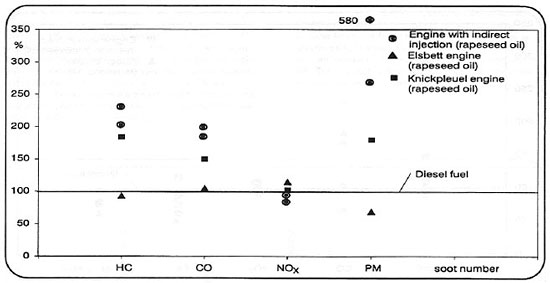
Diagram 2: Emission of regulated compounds in engines fueled with rapeseed oil compared to diesel fuel in the FTP-75 test (DF = 100%).
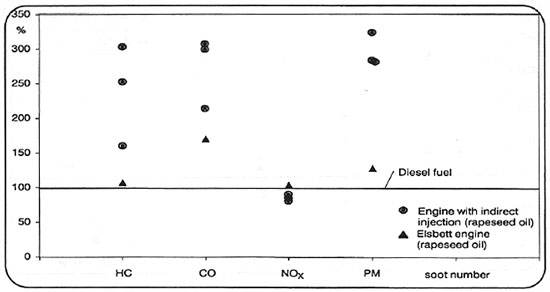
Diagram 3: Emissions of regulated compounds in an engine fueled with rapeseed oil compared to petroleum diesel fuel in the ECE 15-mode test (DF = 100%).
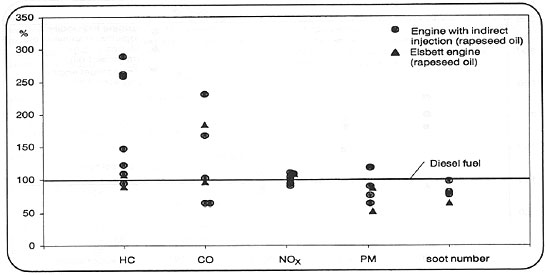
Diagram 4: Emissions of regulated compounds and soot number in engines fueled with rapeseed oil compared to petroleum diesel fuel in the 13-mode test (DF = 100%).
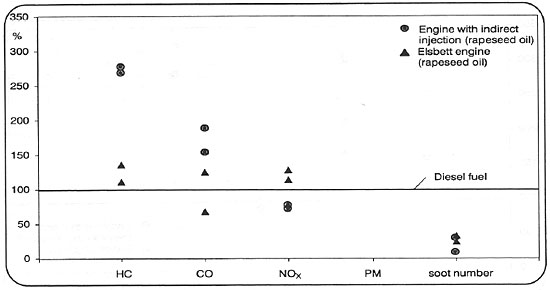
Diagram 5: Emissions of regulated compounds and soot number in engines fueled with rapeseed oil compared to petroleum diesel fuel in the 5-mode test (DF = 100%).
Independent of test cycle, uniform tendencies concerning engine exhaust emissions when fueling with rapeseed oil were observed. HC and CO are increased sharply, whereby the NOx values remain basically unchanged. PM increased when using the transient (automobile) test cycle, while the engine was fueled by 100% rapeseed oil. However, when the results are based on the steady state 13-mode test, a 20% decrease in PM was observed. The soot number was also reduced by about the same amount. An even stronger reduction in soot number (70%) was observed with the use of rapeseed oil.
4.1.2 Comparative Measurements of DF and RME
More results of exhaust gas analyses are available for engines fueled by RME than for rapeseed oil. Diagrams 6 to 11 show the relative differences in values for regulated emissions compounds and soot number compared to DF. The distinction is made here according to the engine test procedure and engine construction.
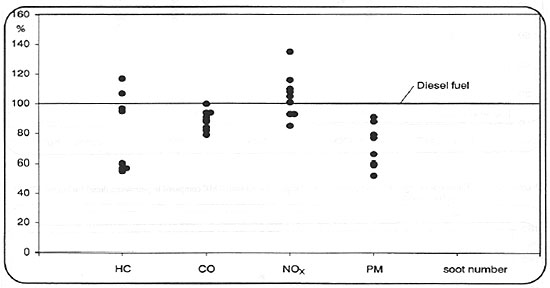
Diagram 6: Emissions of regulated compounds in an IDI engine fueled with RME compared to petroleum diesel fuel in the FTP-75 test (DF = 100%).
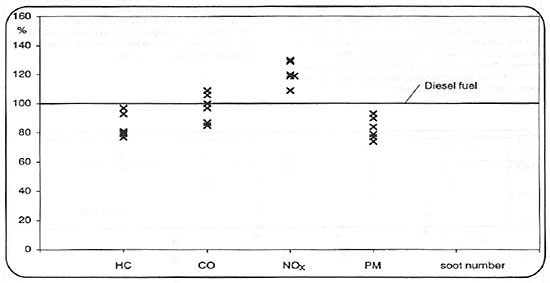
Diagram 7: Emissions of regulated compounds in a DI engine fueled with RME compared to petroleum diesel fuel in the FTP-75 test (DF = 100%).
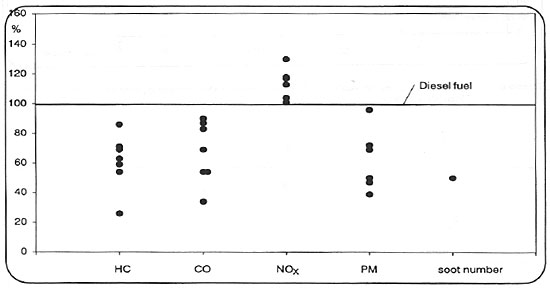
Diagram 8: Emissions of regulated compounds and soot number in an IDI engine fueled with RME compared to petroleum diesel fuel in the 13-mode test (DF = 100%).
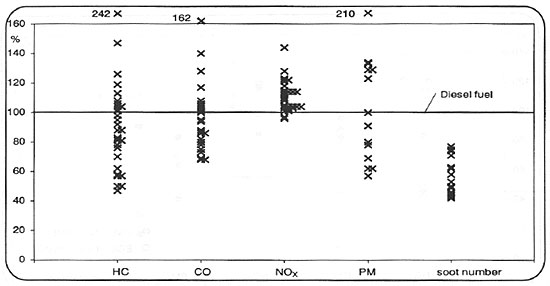
Diagram 9: Emissions of regulated compounds and soot number in a DI engine fueled with RME compared to petroleum diesel fuel in the 13-mode test (DF = 100%).
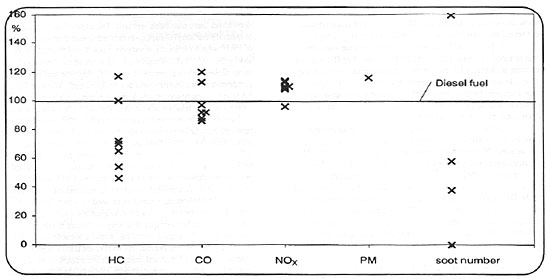
Diagram 10: Emissions of regulated compounds and soot number in a DI engine fueled with RME compared to petroleum diesel fuel in the 5-mode test (DF = 100%).
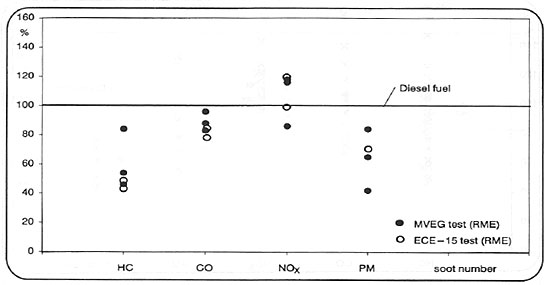
Diagram 11: Emissions of regulated compounds and soot number in an IDI engine fueled with RME compared to petroleum diesel fuel using different test procedures (DF = 100%)
The comparison of steady state and transient test cycles show no significant variations. The use of DI or IDI engines did not reveal any significant advantages for either engine type.
In particular, HC discharge of both engine concepts was reduced by about 20% in the FTP-75 test. For IDI engines running on RME, a HC reduction of approximately 40% in the 13-mode test is observed, whereas this value with DI engines was decreased by only about 10%. These observed tendencies, however, should be interpreted with caution, as a much larger database is available for DI engines.
CO was reduced on average by 15% for all engine designs with RME use, whereby IDI-engines show some advantages. NOx emissions increased by almost 10%. No PM changes were observed for DI-engines tested with the 13-mode test with either RME or rapeseed oil. In almost all other cases, a reduction of approximately 20 to 40% occurred when compared to the DI engine when RME was used. IDI-engines generally emit smaller particulate matter. The soot number is independent of engine design and test cycle. A reduction in soot number of approximately 40% was noted when RME and rapeseed oil were compared to diesel fuel.
4.2 Non-Regulated Exhaust Gas Components PAH, Aldehydes and Aromatic Compounds
In contrast to the diverse comparative measurements of regulated emissions, the availability of data is limited for the non-regulated compounds. Among the unregulated components of exhaust gas, aldehydes have been more thoroughly investigated than PAH. In isolated cases, indications of emissions of benzene and alkyl benzene derivatives have also been reported. The expenditure necessary to quantify carbonyl compounds is much lower compared to that of PAH, which explains the varying amount of information on aldehydes and PAH. Within the framework of the following section, the analytical precision of PAH, aldehyde and aromatic compound determinations will not be discussed. Many of the PAH values are based on single measurements without repetition. The relative deviation of the aldehyde measure with repeated measurements range from ±2 - 20%, whereas the repeated standard deviation with multiple PAH measurements varied from 5 to 40%. Detailed information concerning the following test results of unregulated emissions are documented by Krahl el al. [11], including sources, description of analytical procedures, number of repeated measurements and, when available, relative standard deviation of repeated measurements.
The following criteria were used to select data for comparison purposes:
- common engine test cycle,
- information can be used quantitatively according to the analytical laboratory,
- the engine tested ran without breakdowns at least during the assessment period.
However, the third criterion cannot be equated for actual usage with the suitability of the engine for continuous operation with biofuels. In addition to the selection criteria mentioned above, experiments were also excluded, when the analytical laboratory stated a deviation of ±100%. Diagram 12 illustrates a compilation of the measured values which were considered.
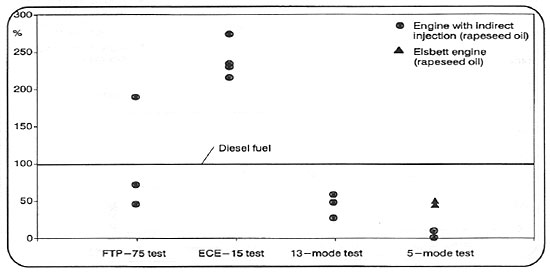
Diagram 12: Relative PAH emissions values from engines fueled with rapeseed oil compared to petroleum diesel fuel (DF = 100%)
4.2.1 Comparative Measurements of PAH in DF and Rapeseed Oil
The results from the FTT-75 cycle show large fluctuations. In the ECE-15 test, an increased PAH emission for rapeseed oil operation when compared to DF operation can be uniformly identified. In contrast, the ECE-R49- and 5-mode tests lead with rapeseed oil operation to a reduction of PAH in the exhaust gas.
In summary, PAH values are strongly decreased in steady-state tests during engine operation with rapeseed oil. PAH are increased in the transient ECE-15 cycle and also in the FTP-75 test. In the 5-mode test, the relative PAH reduction was more pronounced in pre-chambered engines than in the direct injecting Elsbett engine. The original literature, however, indicated that the absolute PAH discharge of pre-chambered engines represented a 10 to 20-fold increase when compared to the Elsbett engine.
4.2.2 Comparative Measurement of PAH with DF and RME
In the final result of the experiments shown in diagram 13, it is clear that fueling with RME significantly reduced PAH exhaust emissions of most engines. This decrease was especially noticeable with the 5-mode test that was designed for agricultural engines. (The strong deviation of a single engine from this otherwise uniform tendency cannot be explained at this time; the test procedure should be repeated with the same type of engine.)

Diagram 13: Relative PAH emissions values from engines fueled with RME compared to petroleum diesel fuel (DF = 100%)
4.2.3 Comparative Measurements of Aldehydes with DF and Rapeseed Oil
Diagram 14 shows a relative comparison of aldehyde and ketone emissions for the varying engine test procedures according to the selection criteria. A drastic rise in aldehyde emissions was noted (200-300% of the DF value) when fueling with rapeseed oil. Formaldehyde and acrolein are largely responsible for this increase, Emissions from pre-chambered engines (IDI) fueled with rapeseed oil tended to increase more strongly than those of Elsbett engines. However, one case showed comparable emissions for both fuels within the limits of deviation.
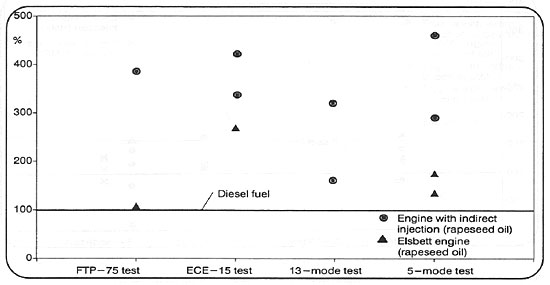
Diagram 14: Aldehydes emissions from engines fueled with rapeseed oil compared to petroleum diesel fuel (DF = 100%)
4.2.4 Comparative Measurements of Aldehydes with DF and RME
The relative values of aldehyde and ketone emissions are represented for the different test cycles in Diagram 15. RME aldehyde emissions increased approximately 40% compared to operation with DF. Again formaldehyde and acrolein were responsible for this increase. It is interesting to note that the upper and lower extreme emissions cases were produced by the same engine manufacturer in the FTP-75 test. There is no certain explanation for this discrepancy. The emissions from one vehicle that was fueled with RME was quite high compared to the other engines that were evaluated. When this case was removed, RME produced a 20% increase in exhaust emissions. The comparison of indirect-injected with direct-injected engines doesn't reveal any particular tendency.
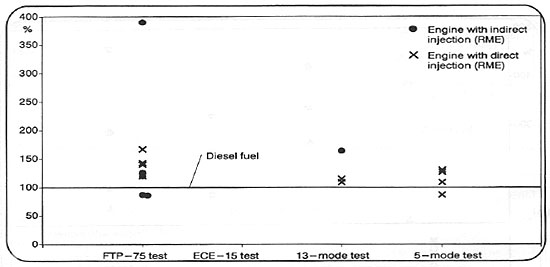
Diagram 15: Aldehydes emissions from engines fueled with RME compared to petroleum diesel fuel (DF = 100%)
4.2.5 Comparative Measurements of Aromatic Compounds
The emissions of benzene, toluene, xylenes (BTX) as well as ethylbenzene have only been sparingly investigated for engines fueled with rapeseed oil and RME. Diagram 16 shows the available information in relative representation. It is clear that for the comparison of RME with DF in the FTP-75 and in 5-mode tests, a reduction of aromatic compounds emissions are found, similar to the levels noted concerning PAH emissions. In contrast, an increase in the level of aromatic emissions can be seen in the outcome of the 13-mode test when the test engine was fueled with rapeseed oil.
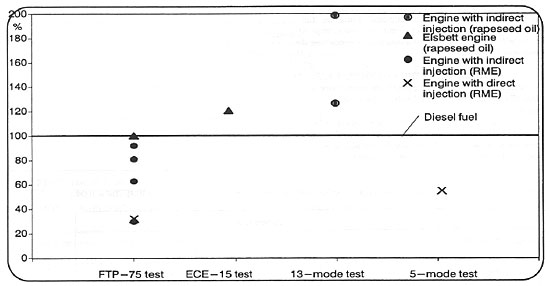
Figure 16: Aromatic emissions from engines fueled with RME compared to petroleum diesel fuel (DF = 100%)
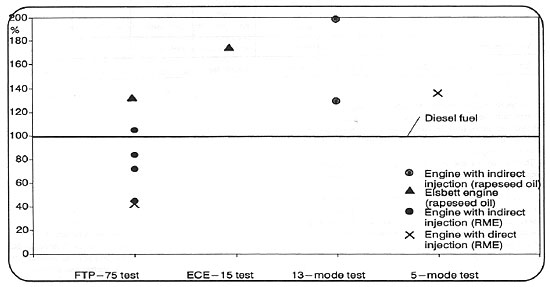
Figure 17: Benzene emissions from engines fueled with RME compared to petroleum diesel fuel (DF=100%)
Total emissions of BTX and ethylbenzene correlate strongly with the measured values for benzene, an especially important compound. Diagram 17 shows the relative emission values of benzene. With the exception of the engine in the 5-mode test, similar tendencies were noted for the sum of the aromatic compounds and benzene emissions. Elsbett engines produced slightly higher levels in benzene emissions when compared to the sum of aromatic compounds emissions. The sharp rise in benzene emissions is significant when compared with the lower total emissions of aromatic compounds from the engine in 5-mode test.
4.3 Summary of the Known Test Results
The influence of rapeseed oil and RME on the emission of federally regulated components has been investigated extensively.
Table 2 presents a summary of average values for engines fueled with rapeseed oil and RME compared to engines powered with diesel fuel. Please note that the table does not indicate the number of measurements conducted.
Table 2: Emissions of regulated compounds and soot number in engines fueled with rapeseed oil and RME (DF = 100%)
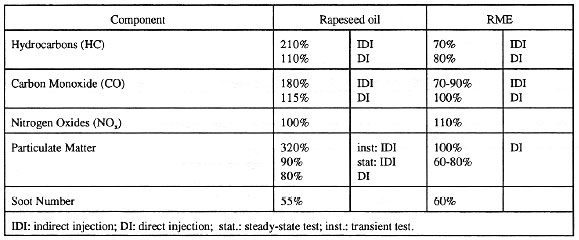
In summarizing the following section concerning non-regulated compounds, the differentiation of the engine design cannot be determined, as too little data were evaluated by the researchers. It must be noted, however, that the PAH values reported in the literature are questionable.
The tendencies stated are not only based on averages of repeated measurements but also on single determinations. Table 3 provides a comparison of measurements for operation with rapeseed oil and RME relative to operation with diesel fuel. The relative values do not indicate the number of underlying measurements nor do they give the accuracy of the repeated measurements; information concerning these factors was documented by Krahl el al. [11].
Table 3: Unregulated emissions from engines fueled with rapeseed oil and RME compared to petroleum diesel fuel (DF = 100%)
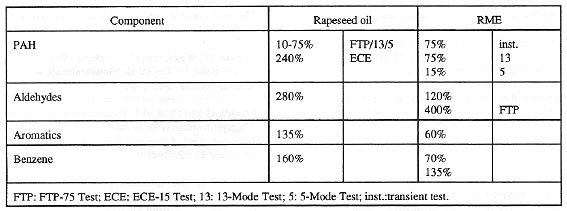
5. Effects of Rapeseed Oil and RME
5.1 Gaseous Regulated Components
No significant differences in direct effects can be deduced from changes in the gaseous regulated components. Section 5.3 discusses possible indirect photochemical effects of specific hydrocarbons.
5.2 PAH, Particulate Matter and Soot
Because PAH have a higher carcinogenic potential synergistically with soot particles than each component alone (Heinrich, [39]), an estimation of the cancer-inducing effect of exhaust gas is only possible when considering these compounds collectively. When discussing soot particles, it is also relevant, that pure carbon on which no compounds have accumulated can also induce lung cancer. Krahl [40] summarized previous research, which show that particle size and distribution frequency from the filtrate of undiluted exhaust gas from diesel fuel and RME present dissimilarities that favor the use of the alternative fuel. Parallel to this result, a considerable reduction in PAH emissions has been noted when fueling with RME. Using Salmonella cultures, Stalder et al. [41] noted a reduction of mutagenic potential in RME particulate matter during full load and idle when compared to that of diesel fuel. Similar results were found by Eckl [42].
The data were not uniformly distributed when unmodified for rapeseed oil was used as fuel. PAH and particulate matter concentrations were less modified with the use of rapeseed oil. Mutagenicity tests similarly show strong fluctuations (Stalder et al., [43]).
At this time, research is still needed on the mutageriic and carcinogenic effects of particulate matter for both RME and raw rapeseed oil. The continuing investigation on the influence of biofuels on soot particle size and concentration is also of importance. It should be reiterated, that current knowledge indicates clear advantages for RME regarding soot, particle and PAH emission in conjunction with distribution of particles and mutagenic potential. Only non-uniform results were noted for raw rapeseed oil.
5.3 Aldehydes
The discharge of aldehydes into the atmosphere is of environmental relevance in two ways (see section 3.3). In light of the direct effect of aldehydes, Wolfensberger [44], during a preliminary experiment in the city of Zurich, noted that exhaust gas fumes from busses run with RME caused some of the maintenance staff and drivers to become ill. However, the typical odor of vegetable oil fuels was practically eliminated by a oxidative catalytic convertor (see also Krausgrill and Schmidt, [45]. Stalder et al. [41] found in preliminary laboratory experiments that RME-soot elevated cytotoxicity. Additional systematic experiments, however, could lead to more certain results. Aldehydes also have a great influence on tropospheric ozone formation. Because aldehydes from diesel engine combustion eventually contribute to more than 40% of the ozone-forming potential, the increase in aldehyde discharge (which is sometimes extreme, as in the case of operation with raw rapeseed oil) deserves attention, especially when vehicles fueled by RME and rapeseed oil are used in cities. The increase of ethene and ethyne which has been determined during engine operation with RME (Wurst et al., [21] is also worthy of consideration. Together both components are suspected to contribute to over 30% of the total formation of ozone induced by diesel engines (Hartung, [46].
Consequently there exists a considerable need for research in the area of aldehydes, alkenes and alkynes, if biofuels are to be used in overcrowded industrial regions.
5.4 Aromatic Compounds
Emissions of aromatic compounds are decreased when fueling with RME. However, they are elevated for rapeseed oil. Wurst el al. [21] reported a distinct increase of benzene emissions during the 5-mode test. This phenomenon cannot be satisfactorily explained. A need exists for research concerning the ozone-forming potential of the alkyl derivatives of benzene found in RME exhaust gas. The benzene emissions and their environmental impact should be systematically investigated at the same time.
5.5 Conclusion
The comprehensive review of all research shows both advantages and disadvantages for rapeseed oil and RME usage. The direct acting disadvantages are less pronounced for RME as for rapeseed oil, A definitive evaluation can partially be found in the Unit-Risk-Assessment of Otto-(gasoline) and Diesel engines, recently published [41] by the "Sachverständigenrat für Umweltfragen." This publication, however, needs to expand upon specific characteristies of biofuels including the size distribution of soot particles. In light of the effects of emissions, future research should include a systematic investigation of the cytotoxic, mutagenic and carcinogenic characteristics of these alternative fuels. Likewise, the ozone-forming potential of vegetable oil fuels, when used in regions other than agricultural areas, should be determined.
Summary
Based on the extensive literature about exhaust gas emissions resulting from the combustion of rapeseed oil and its methyl ester (RME), data were compiled and differentiated according to the underlying engine test procedure, fuel and engine design. In light of the known effects of individual exhaust gas components presented in the beginning, an effort was made to estimate the environmental relevance of rapeseed oil and RME compared to diesel fuel. RME seems to present fewer disadvantages of the two fuels compared based on current knowledge. However, in order to make a sound evaluation of the emissions characteristics of these alternative biofuels, additional research is necessary. Unregulated exhaust gas emissions must be determined. Likewise, the mutagenic, carcinogenic and cytotoxic effects resulting from rapeseed oil or RME use have not been sufficiently investigated when compared to the on-going investigation of effects of petroleum diesel. In addition, in order to utilize these alternative fuels in regions with high NOx concentration, it is necessary to determine the expected ozone formation in low altitudes that result from their emissions and to compare this with that of petroleum diesel fuel.
References
1. Vellguth, G. Eignung von Pflanzenölen und Pflanzenöldefivaten als Kraftstoff für Dieselmotoren. Grundl. Landtechnik 32, pp. 17-186. 1982.
2. Vellguth, G. Emissionen bei Verwendung alternativer Kraftstoffe in Schlepper-Dieselmotoren. Grundl. Landtechnik 37, pp. 207-213. 1987.
3. Gorse, R. A., Benson, J.D., Burns, K.R., Hochhauser, A.M., Koehl, W.J., Painter, L.J., Reuter, R.M., and Rippon, B.H. Toxic Air Pollutant Vehicle Exhaust Emissions with Reformulated Gasolines. -SAE-Paper 912324. 1991.
4. Sachverständigenrates für Urnweltfragen. Urnweltgutachten 1994. Kusterdingen, Meltzer- Poeschel-Verlag. 1994.
5. Schäfer, F. Gesetzliche Vorschriften zur Schadstoff - und Verbrauchsbegrenzung bei Pkw - Verbrennungsmotoren. Motortechn. Zeitschrift 52, pp 346-355, 1991.
6. Menrad, H., Weidmann, K., Bernhard, W., Heilmann, G., and Behn, U. Rapsöl als Motorkraftstoff. - Mineraldtechnik. 5-6. 1989.
7. Frinkle, G. and Stein, H.J. Instationüre oder stationäre Abgasprüfverfahren für Nutzfahrzeug- Dieselmotoren? Automobiltechn. Zeitschrift 90, pp 15-22 and 85-92. 1988.
8. Welschof, G. Der Ackerschepper - Mittelpunkt der Landtechnik. VDI-Berichte 407, Düsseldorf, VDI- verlag, pp. I I - 17. 199 1.
9. Länderausschuss Für Immissionsschutz - Krebsrisiko durch Luftverunreinigungen. Ministerium für Umwelt, Raumordnung und Landwirtschaft des Landes Nordrhein- Westfalen, Düsseldorf 1992.
10. Lenz, H.P., Pucher, E., Kohoutex, P., Rennenberg, H., Hahn, J., Elstner, E.F., and Hippeli, S. Emissionen, Imissionen und Wirkungen van Abgaskomponenten. - VDI-Fortschrittbericht, Reihe 12, Nr, 183, Düsseldorf, VDI-Verlag. 1993.
11. Krahl, J., Vellguth, G., and Munack, A. Übersicht von arbeiten zum Einsatz von Rapsöl und Rapsölmethylester als Kraftstoffe unter Berücksichtigung urnweltrelevanter Auswirkungen. Final-report: Institute of Biosystems Engineering, FAL, Braunschweig (D). 1994.
12. Henschler, D. Bedeutung der Schadstoffemissionen aus Verbremungsmotoren für den Menschen und die Umwelt. Tagungsband Emissionen von Pflanzenölkraftstoffen und ihre Umweltwirk-ungen, S. 14-18, Würzburg, C.A.R.M.E.N.-Eigenverlag, 1994.
13. Carter, P.L.W. Development of Ozone Reactivity Scales for Volatile Organic Compounds. - US Environmental Protection Agency Report EPA 600/3- 91/050. 1991.
14. Huber, L., Emmert, J., Gratzfeld-Hüsgen, A. and Dulson, W. Bestimmung von polycyclischen Aromaten mit HPLC, UV/VIS Diodenarray und Fluoreszenzdetektion. -Staub-Reinhalt. Luft 47, S. 22- 27. 1997.
15. Heinrich, U. Polyzyklische Aromostische Kohlenwasserstoffe - Tierexperimentelle Egrebnisse. VDI-Tagungsband Krebserzeugende Stoffe in der Umwelt, 23./25.4.1991, Mannheim, Kurzfassung. 1991.
16. Kaschani, D.T. and Brauns, A. Bestimmung van PAHs in Kraffahzeugabgasen durch HPLC (Teil 2). - GIT Spezial Chromatogr. 2, S. 66-76. 1991.
17. Grover, P.L. Pathways Involved in the Metabolism and Activation of Polycyclic Hydrocarbons. - Xenobiotica 16, S. 915-931. 1986.
18. Pott, F. Dieselmotorabgas - Tierexperimentelle Ergebnisse zur Risikoabschätzung. -VDI-Berichte 888, S. 211-243, Düsseldorf, VDI-Verlag. 1991.
19. Boeckh, M. Des Diesels Kem. -VDI-Nachrichten Nr. 36, S. 3. 1992.
20. Henschler, D. Dieselmotor-Emissionen. -Lfg 13, Weinheim, Verlag Chemie. 1997.
21. Wurst, F., Boos, R., Prey, R., Scheidl, K., and Wörgetter, M. Emissionen beim Einsatz von Rapsölmethylester an einem Prufstandsmotor. Forschungsberichte der Bundesanstalt für Landtechnik, Vol. 22, Wieselburg (A). 1990.
22. Office of Health. Health Assessment Document for Acrolein, -EPA/600/8-86/014 F. 1990.
23. Lofti, C.F.P., Brentani, M.M., and Böhm, G.M. Assessment of the Mutagenic Potential of Ethanol Auto Engine Exhaust Gases by the Salmonella typhimunum Microsomal Mitagenesis Assay, Using a Direct Exposure Method. -Environ. Research 52, S. 225-230, 1990.
24. Moussiopoulos, N., Oehler, W., and Zellner, U. Kraftfahzeugenissionen und Ozonbddun& -Berlin, Heidelberg, New York, Paris, Tokyo, Hong Kong, Springer-Verlag, 1989.
25. Wagner, H.M. Anthropogenes Ozon ("Sommersmog") - Entstehung, Vorkommen und Gesundheitliches Risiko. -Wissenschaft und Umwelt 1-2, S, 15-20. 1991.
26. Sattler, T. and Jaeschke, W, Modell zur Ausbreitung Kfz-bedingter Lufkschadstoffe in einem Baumbestand. -Staub-Reinhalt. Luft 50, S. 331-337, 1990.
27. Reichow, H.P. Luftverkehr und Umwelt. -VDI- Berichte 943, S. 133-150, Dasseldorf, VDI-Verlag. 1992.
28. Krumm, H., Reglitzky, A.A., and Schneider, H. Energieeinsparung und Minderung der C02- Emissionen bei konventionellen und Landwirtschaft des Landes Nordrhein-Westfalen, Düsseldorf 1992,
29. Hockel, K.G.L.,Langen, P.,and MaIlog, J. Abgas-Emissionsredusierung - Eine Herausforderung für die Automobilindustrie. -Motortechn. Zeitschrift 53, S. 326-338. 1992.
30. Bayerl, W., Müller, A., and Schäffer, H. EinfluB der Kraftstoffzusammensetzung auf die Kohnlenwasserstoffemissionen von Ottomotoren. - Motortechn. Zeitscrift 53, S. 584-590. 1992.
31. Boyd, J.D. Aspects of Alternative Energies for Automotive Propulsion - A California Prospect -VDI- Berichte 1020, Tagungsanlage, S. 1- 11 1992.
32. CARB. Determination of Non-Methane Hydrocarbon Mass Emissions by Flame Ionisation Detection (Draft). 1992.
33. CARB. Tagungsanlage Reactivity Meeting, 8./9. April 1991, Berkman Center of National Academics of Sciences and Engineering, Irvine, CA (USA). 199la.
34. CARB. Notice of Public Hearings to Consider Amendments to Regulations Regarding the Calculation and Use of Reactivity Adjustment Factors for Passenger Cars and Light-Duty Trucks Certifying to Transitional Low-Emission Vehicle Exhaust Emission Standards. -Mail-Out, 5. 91-43. 1991b.
35. Kröll, M., Decker, G., Hartung, K, Postulka. A., and Georgi, B. Influence of Fuel Composition on NMOG- Emissions and Ozone Forming Potential. -SAE-Paper 932676. 1993.
36. Chang, T.Y. and Rudy, S.J. Ozone-Forming Potential or Organic Emissions from Alternative-Fueled Vehicles. -Atmospheric Environm. 24a, S. 2421- 2430.1990.
37. Scharmer, K., Glüsing, H., and Krings, L. Standardanforderungen an Rapsölmethylester als Motorenkraftstoff. Teil I. Stand der Technik. Report: Gesellschaft für Entwicklungstechnolgie, Aldenhoven (D). 1993.
38. Irmscher, I. and Jaskulla, N. Aspekte des motoischen Vcrhaltcns von Kraftstoffen aus planzlichen Ölen - Stand der internationalen Forschung, Final report: Verein für Innovative Verkehrstechnik, Berlin. 1994.
39. Heinrich, U. Wirkungsforschung bei Dieselmotoremissionen. Proceedings. Emissionen von Pflanzenölkraftstoffen und ihre Umweltwirkungen. C.A.R.M.E.N.-Verlag Würzburg(D), pp. 19-29. 1994.
40. Krahl, J. Bestimmung der Schadstoffemissionen von landwirtschaftlichen Scleppern beim Betrieb mit Rapsöl im Vergleich zu Dieselkraftstoff. -VD1- Fortschriftberichte, Reiche 15, Nr. 110, Düsseldorf, VDI-Verlag. 1993.
41. Stalder, K., Gerhard, V., Frohmann, H., and Krahl, J. Zytotoxizität und Mutagenität von DieselruB bei Verwendung von Rapsölmethylester als Kraftstoff. Verbandlungen der Deutschen Geselischaft für Arbeits Und Umweltmedizin, 33, pp. 75-78. 1993.
42. Eckl, P. Vergleich der Mutagenität von Diesel - und Rapsmethylester-Abgas. Proceedings: Emissionen von Pflanzenölkraftstoffen und ihre Umweltwirkungen. C.A.R.M.E.N.-Verlag, Würzburg (D), pp. 109-119. 1994.
43. Stalder, K., Gerhard, V., and Krahl, J. Zur Kanzerogenen Wirking von RuBen aus Dieselmotoren un Betrieb mit Rapsöl, RME und Dieselkraftstoff. - Tagungsband Emissionen von Pflanzenölkraftstoffen und ihre Umweltwirkungen, S. 30-35, Würzburg, C.A.R.M.E.N.-Eigenverlag, 1994.
44. Wolfensberger, U. Hat Biodiesel in der Schweiz eine Chance? Raps 12 (1), pp. 12-14. 1994.
45. Krausgrill, C. and Schmidt, C. AbschluBbericht RME- Projekt stadt Fulda. Final report: Technical University Darmstandt (D). 1993.
46. Hartung, A. Personal Information, Volkswagen AG. 1993.
Back to Biofuels Library
Back to Straight vegetable oil as diesel fuel: References
Biofuels
Biofuels Library
Biofuels supplies and suppliers
Biodiesel
Make your own biodiesel
Mike Pelly's recipe
Two-stage biodiesel process
FOOLPROOF biodiesel process
Biodiesel processors
Biodiesel in Hong Kong
Nitrogen Oxide emissions
Glycerine
Biodiesel resources on the Web
Do diesels have a future?
Vegetable oil yields and characteristics
Washing
Biodiesel and your vehicle
Food or fuel?
Straight vegetable oil as diesel fuel
Ethanol
Ethanol resources on the Web
Is ethanol energy-efficient?
